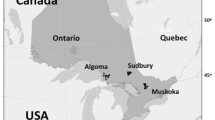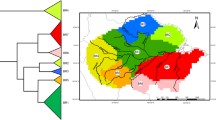We tested two hypotheses about boundary units and seven about environmental control of species diversity in order to explain geographical trends in the richness of amphibian species in the Mediterranean watershed of the southern coast of the Iberian Peninsula. The number of amphibian species tends to decrease from west to east. The longitudinal trend in the richness of amphibian species actually occurs on passing from one basin to another, but there is not any longitudinal trend within the basins. Multivariate analyses confirmed that the disturbances of episodic river-basin floodings were the principal factor which controls the richness of amphibian species. They explained 94.8% of the observed variations in the richness of amphibian species in this area, according to the intermediate disturbance hypothesis.
We propose hydrographic basins as suitable geographical units for further biogeographical analysis and for considering the role of disturbances produced by floods in the environmental control of species diversity.
Similar content being viewed by others
References
Abramsky, Z. and Rosenzweig, M.L. (1984) Tilman's predicted productivity-diversity relationship shown by desert rodents.Nature 309, 150–1.
Antúnez, A., Real, R. and Vargas, J.M. (1988) Análisis biogeográfico de los anfibios de la vertiente sur de la cordillera Bética.Miscel. Zool. 12, 261–72.
Arnold, S.J. (1972) Species densities of predators and their prey.Am. Nat. 106, 220–36.
Ball, I.R. (1975) Nature and formulation of biogeographical hypotheses.Syst. Zool. 24, 407–30.
Baroni-Urbani, C. and Collingwood, C.A. (1976) A numerical analysis of the distribution of British Formicidae (Hymenoptera, Aculeata).Verhandl. Naturf. Ges. Basel 85, 51–91.
Baroni-Urbani, C. and Collingwood, C.A. (1977) The zoogeography of ants (Hymenoptera, Formicidae) in Northern Europe.Acta Zool. Fennica 152, 1–34.
Baroni-Urbani, C., Ruffo, S. and Vigna-Taglianti, A. (1978) Materiali per una biogeografia Italiana fondata su alcuni generi di coleotteri cicindelidi, carabidi e crisomelidi.Esir. Mem. Soc. Entomol. Ital. 56, 35–92.
Bea, A. (1981) Herpetofauna de Guipúzcoa: estudio faunístico y relaciones con la climatología.Munibe 33, 115–54.
Bell, G. and Lawton, J.H. (1975) The ecology of the eggs and larvae of the smooth newt (Triturus vulgaris (Linn.)).J. Anim. Ecol. 44, 393–423.
Blondel, J. (1986)Biogéographie évolutive. Paris: Masson.
Boucher, C. (1986) Bioclimatologie et floristique d'Andalouisie.Ecol. Med. 12, 101–30.
Brown, J.H. (1988) Species diversity. InAnalytical Biogeography. An Integrated Approach to the Study of Animal and Plant Distributions (A.A., Myers and P.S., Giller, eds) pp. 57–89. New York: Chapman & Hall.
Brown, J.H. and Gibson, A.C. (1983)Biogeography. St Louis, MO: Mosby.
Busack, S.D. and Hedges, S.B. (1984) Is the peninsular effect a red herring?Am. Nat. 123, 266–75.
Busack, S.D. and Jaksic, F.M. (1982) Ecological and historical correlates of Iberian herpetofaunal diversity: an analysis at regional and local levels.J. Biogeogr. 9, 289–302.
Capel, J.J. (1981)Los climas de España. Barcelona: Oikos-tau.
Cerezuela, F. (1977)Evapotranspiración y microclimas de la vertiente mediterránea del sur de España. Málaga: Universidad de Málaga.
Chang, D.H.S. and GauchJr, H.G. (1986) Multivariate analysis of plant communities and environmental factors in Ngari, Tibet.Ecology 67, 1568–75.
Colinvaux, P.A., Miller, M.C., Liu, K., Steinitz-Kannan, M. and Frost, I. (1985) Discovery of permanent Amazon lakes and hydraulic disturbance in the upper Amazone Basin.Nature 313, 42–5.
Confederación Hidrográfica del Sur de España (1987)Datos fisicos de las cuencas que vierten al Mar Mediterráneo entre Tarifa (Cádiz) y Águilas (Murcia). Málaga: Servicio de Hidrología.
Connell, J.H. (1978) Diversity in tropical rain forest and coral reefs.Science 199, 1302–310.
Connell, J.H. and Orias, E. (1964) The ecological regulation of species diversity.Am. Nat. 98, 399–414.
Culver, D.C. (1970) Analysis of simple cave communities. I. Caves as islands.Evolution 24, 463–74.
Currie, D.J. (1991) Energy and large-scale patterns of animal- and plant-species richness.Am. Nat. 137, 27–49.
Currie, D.J. and Paquin, V. (1987) Large-scale biogeographical patterns of species richness of trees.Nature 329, 326–7.
Doadrio, I. (1988) Delimitation of areas in the Iberian Peninsula on the basis of fresh water fishes.Bonn. zool. Beitr. 39, 113–28.
Duellman, W.E. and Trueb, L. (1986)Biology of Amphibians. New York: McGraw-Hill.
Fischer, A.G. (1960) Latitudinal variation in organic diversity.Evolution 14, 64–81.
Font, I. (1983)Atlas climático de España. Madrid: Instituto Nacional de Meteorología.
Giller, P.S. and Gee, J.H.R. (1987) The analysis of community organization: the influence of equilibrium, scale and terminology. InOrganization of Communities. Past and Present. (J.H.R., Gee and P.S., Giller, eds) pp. 519–42. Oxford: Blackwell Scientific Publications.
Gómez-Moreno, M.L. (1987)Apuntes de geografía física de Andalucía. Málaga: Universidad de Málaga.
Gracia, P. (1988)Atlas de distribución de los anfibios en la provincia de Granada. Universidad de Granada: Tesis de Licenciatura.
Gracia, P. and Pleguezuelos, J.M. (1990) Distribución de los anfibios en la provincia de Granada (SE Peninsula Ibérica).Anales de Biología 16, 71–84.
Grimsdell, J.J.R. and Raw, L.R.G. (1984) Frog species diversity in relation to bioclimatic regions and conservation areas in Natal.Lammergeier 33, 21–9.
Gudynas, E. (1984) Sobre el Río Uruguay como barrera biogeográfica para los anfibios, y la significación de la presencia deLeptodactylus chaquensis Cei, 1950 (Anura, Leptodactylydae) en el Uruguay.Bol. Soc. Zool. Urug. (Segunda Época)2, 78–89.
Hengeveld, R. (1990)Dynamic Biogeography. Cambridge: Cambridge University Press.
Huey, R.B. (1978) Latitudinal pattern of between-altitude faunal similarity: mountains might be ‘higher’ in the tropics.Am. Nat. 112, 225–54.
Huston, M. (1979) A general hypothesis of species diversity.Am. Nat. 113, 81–101.
Janzen, D.H. (1967) Why mountain passes are higher in the tropics.Am. Nat. 101, 233–49.
Karr, J.R. and Roth, R.R. (1971) Vegetation structure and avian diversity in several new world areas.Am. Nat. 105, 423–35.
Kiester, A.R. (1971) Species density of North American amphibians and reptiles.Syst. Zool. 20, 127–37.
Kitchener, D.J. (1982) Predictors of vertebrate species richness in Nature reserves in the Western Australian wheatbelt.Aust. Wildl. Res. 9, 1–7.
Klopfer, P.H. (1959) Environmental determinants of faunal diversity.Am. Nat. 93, 337–42.
Lambert, S. and Reid, W.H. (1981) Biogeography of the Colorado herpetofauna.Am. Midl. Nat. 106, 145–56.
Legendre, L. and Legendre, P. (1979)Ecologie numérique. 2. La structure des données écologiques. Paris: Masson.
Long, G. (1974)Diagnostic phyto-écologique et aménagement du territoire. Vols 1, 2. Paris: Masson.
MacArrhur, R.H. (1964). Environmental factors affecting bird species diversity.Am. Nat. 98, 387–97.
MacArthur, R.H. and Wilson, E.O. (1967)The Theory of Island Biogeography. Princeton: Princeton University Press.
Major, J. (1963) A climatic index to vascular plant activity.Ecology 44, 485–98.
Mann, W., Dorn, P. and Brandl, R. (1991) Local distribution of amphibians: the importance of habitat fragmentation.Global Ecol. Biogeogr. Lett. 1, 36–41.
Martín, J. and Gurrea, P. (1990) The peninsular effect in Iberian butterflies (Lepidoptera: Papilionoidea and Hesperoidea).J. Biogeogr. 17, 85–96.
Mattews, W.J. and Robison, H.W. (1988) The distribution of the fishes of Arkansas: a multivariate analysis.Copeia 1988, 358–74.
McCoy, E.D. and Connor, E.F. (1980) Latitudinal gradients in the species diversity of North American mammals.Evolution 34, 193–203.
Meentemeyer, V. (1978) Macroclimate and lignin control of litter decomposition rates.Ecology 59, 465–72.
Menge, B.A. and Sutherland, J.P. (1976) Species diversity gradients: synthesis of the roles of predation, competition, and temporal heterogencity.Am. Nat. 110, 351–69.
Montero de Burgos, J.L. and González Rebollar, J.L. (1974)Diagramas bioclimáticos. Madrid: Instituto para la Conservación de la Naturaleza.
Owen, J.G. (1988) On productivity as a predictor of rodent and carnivore diversity.Ecology 69, 1161–5.
Owen, J.G. (1989) Patterns of herpetofaunal species richness: relation to temperature, precipitation, and variance in elevation.J. Biogeogr. 16, 141–50.
Paine, R.T. (1966) Food web complexity and species diversity.Am. Nat. 100, 65–75.
Pérez-Mellado, V. (1983) La herpetofauna de Salamanca: un análisis biogeográfico y ecológico.Salamanca, Revista Provincial de Estudios 9–10, 9–78.
Peters, R.H. (1976) Tautology in evolution and ecology.Am. Nat. 110, 1–12.
Petraitis, P.S., Latham, R.E. and Niesenbaum, R.A. (1989) The maintenance of species diversity by disturbance.Quart. Rev. Biol. 64, 393–418.
Planka, E.R. (1966) Latitudinal gradients in species diversity: a review of concepts.Am. Nat. 100, 33–46.
Porter, J.W. (1972) Predation byAcanthaster and its effect on coral species diversity.Am. Nat. 106, 487–92.
Poulson, T.L. and Culver, D.C. (1969) Diversity in terrestrial cave communities.Ecology 50, 153–7.
Räsänen, M.E., Salo, J.S. and Kallioda, R.J. (1987) Fluvial perturbance in the western Amazon Basin: regulation by long-term sub-Andean tectonics.Science 238, 1398–401.
Richerson, P.J. and Lum, K. (1980) Patterns of plant species diversity in California: relation to weather and topography.Am. Nat. 116, 504–36.
Rivas-Martínez, S. (1985)Biogeografía y vegetación. Madrid: Academia de Cieneias Físicas y Naturales.
Rogers, J.S. (1976) Species density and taxonomic diversity of Texas amphibians and reptiles.Syst. Zool. 25, 26–40.
Rosenzweig, M.L. (1968) Net primary productivity of terrestrial communities: prediction from climatological data.Am. Nat. 102, 67–74.
Sale, P.F. (1977) Maintenance of high diversity in coral reef fish communities.Am. Nat. 111, 337–59.
Salo, J., Kallioda, R., Häkkinen, I., Mäkinen, Y., Pekka, N., Puhakka, M. and Coley, P.D. (1986) River dynamics and the diversity of Amazon lowland forest.Nature 322, 254–8.
Schall, J.J. and Pianka, E.R. (1977) Species densities of reptiles and amphibiams on the Iberian Peninsula.Doñana Acta Vertebrata 4, 27–34.
Schall, J.J. and Pianka, E.R. (1978) Geographical trends in number of species.Science 201, 679–86.
Sepkoski, J.J.Jr and Rex, M.A. (1974) Distribution of freshwater mussels: coastal rivers as biogeographic islands.Syst. Zool. 23, 165–88.
Servicio Geográfico del Ejército (1979–1986).Mapa Militar de España. Sheets 4–11, 4–12, 5–11, 6–11. Scale 1:200 000. Madrid: Servicio Geográfico del Ejército.
Siegel, S. (1972)Estadística no paramétrica aplicada a las ciencias de la conducta. México D.F.: Trillas.
Simberloff (1976) Species turnover and equilibrium island biogeography.Science 194, 572–8.
Slatkin, M. (1974) Competition and regional coexistence.Ecology 55, 128–34.
Sokal, R.R. and Rohlf, F.J. (1969)Biometría. Principios y métodos estadísticos en la investigación biológica. Madrid: H. Blume.
Sousa, W.P. (1984) The role of disturbance in natural communities.Ann. Rev. Ecol. Syst. 15, 353–91.
Stephenson, N.L. (1990) Climatic control of vegetation distribution: the role of the water balance.Am. Nat. 135, 649–70.
Terborgh, J. (1971) Distribution on environmental gradients: theory and a preliminary interpretation of distributional patterns in the avifauna of the Cordillera Vilcabamba, Perú.Ecology 52, 22–40.
Terborgh, J. (1973) On the notion of favorableness in plant ecology.Am. Nat. 107, 481–501.
Terborgh, J. (1977) Bird species diversity on an Andean elevation gradient.Ecology 58, 1007–19.
Tilman, D. (1982)Resource Competition and Community structure. Princeton: Princeton University Press.
Turner, J.R.G., Lennon, J.J. and Lawrenson, J.A. (1988) British bird species distribution and the energy theory.Nature 335, 539–41.
Wyman, R.L. (1988) Soll acidity and moisture and the distribution of amphibians in five forests of Southcentral New York.Copeia 1988, 394–9.
Author information
Authors and Affiliations
Rights and permissions
About this article
Cite this article
Real, R., Vargas, J.M. & Antúnez, A. Environmental influences on local amphibian diversity: the role of floods on river basins. Biodivers Conserv 2, 376–399 (1993). https://doi.org/10.1007/BF00114041
Received:
Accepted:
Issue Date:
DOI: https://doi.org/10.1007/BF00114041




